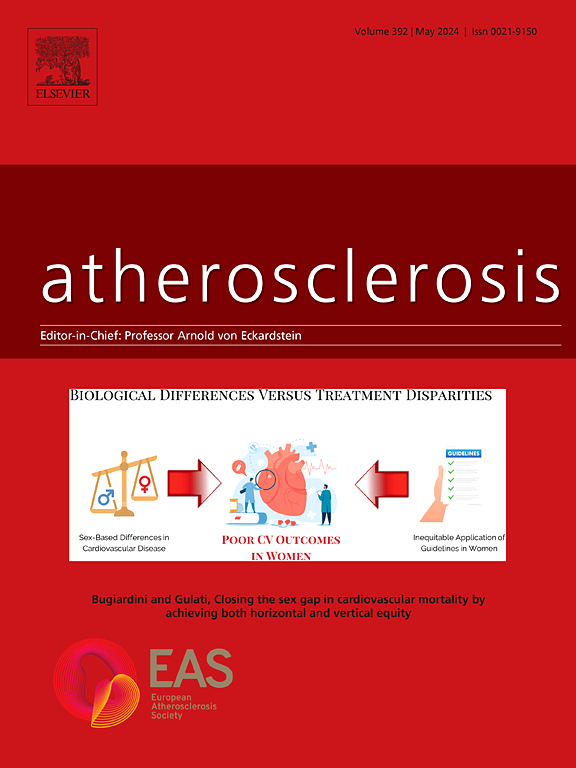血浆caspase-1水平与心血管疾病之间的关系,以及代谢综合征的介导作用
IF 4.9
2区 医学
Q1 CARDIAC & CARDIOVASCULAR SYSTEMS
引用次数: 0
摘要
目的:本研究旨在探讨血浆caspase-1水平与心血管疾病(CVD)的关系,以及代谢综合征(Mets)在这一关系中的潜在介导作用。方法:本研究分析了UK Biobank Precision Proteomics Project (UKB-PPP)中检测参与者血浆caspase-1水平的数据。CVD按照ICD-9/ICD-10编码定义。采用Cox比例风险回归模型探讨血浆caspase-1水平与CVD的风险比(HR)。通过中介分析,探讨met及其成分在这一关系中的中介作用。结果:本研究共纳入41499名参与者。其中,4869名(11.7%)参与者在中位13.6年的随访期间被记录为患有心血管疾病。在完全调整后的模型中,与血浆caspase-1水平最低分位数的个体相比,血浆caspase-1水平最高分位数的个体与CVD风险增加显著相关(HR = 1.11, 95% CI, 1.04-1.19)。血浆caspase-1浓度的每单位规范化蛋白表达(NPX)增加与CVD风险增加6%相关(p<0.001)。代谢产物的调节作用最大,为17.5%,其中高血压、中心性肥胖、高甘油三酯血症、高血糖和血脂异常的调节作用分别为13.52%、9.72%、7.35%、4.63%和2.74%。结论:较高的血浆caspase-1水平与较高的心血管疾病风险相关。这种关联可能部分由Mets及其组分介导,提示caspase-1可能通过增加Mets的发生而增加CVD的风险。本文章由计算机程序翻译,如有差异,请以英文原文为准。

Associations between plasma caspase-1 levels and cardiovascular disease, with the mediating role of metabolic syndrome
Aims
This study aimed to explore the association between plasma caspase-1 levels and cardiovascular disease (CVD), as well as the potential mediating role of metabolic syndrome (Mets) in the association.
Methods
This study analyzed the UK Biobank Precision Proteomics Project (UKB-PPP), which detected plasma caspase-1 levels in participants. CVD was defined by ICD-9/ICD-10 codes. The Cox proportional hazards regression model was used to explore the hazard ratio (HR) of plasma caspase-1 levels with CVD. Mediation analysis was conducted to investigate the mediating effect of Mets and its components on this relationship.
Results
This study included a total of 41,499 participants. Among them, 4869 (11.7 %) participants were documented to have developed CVD during a median follow-up of 13.6 years. In the fully adjusted model, compared with individuals in the lowest tertile of plasma caspase-1 levels, the highest tertile was significantly associated with an increased risk of CVD (HR = 1.11, 95 % CI, 1.04–1.19). Per one-unit Normalized Protein eXpression (NPX) increment in plasma caspase-1 concentrations was associated with a 6 % higher risk of CVD (p<0.001). The mediating effect of Mets was the largest, at 17.5 %, with its components hypertension, central obesity, hypertriglyceridemia, hyperglycemia and dyslipidemia mediated the effects by 13.52 %, 9.72 %, 7.35 %, 4.63 % and 2.74 %, respectively.
Conclusions
Higher plasma caspase-1 levels were associated with a higher risk of CVD. This association may be partially mediated by Mets and its components, suggesting that caspase-1 may increase the risk of CVD by increasing the occurrence of Mets.
求助全文
通过发布文献求助,成功后即可免费获取论文全文。
去求助
来源期刊

Atherosclerosis
医学-外周血管病
CiteScore
9.80
自引率
3.80%
发文量
1269
审稿时长
36 days
期刊介绍:
Atherosclerosis has an open access mirror journal Atherosclerosis: X, sharing the same aims and scope, editorial team, submission system and rigorous peer review.
Atherosclerosis brings together, from all sources, papers concerned with investigation on atherosclerosis, its risk factors and clinical manifestations. Atherosclerosis covers basic and translational, clinical and population research approaches to arterial and vascular biology and disease, as well as their risk factors including: disturbances of lipid and lipoprotein metabolism, diabetes and hypertension, thrombosis, and inflammation. The Editors are interested in original or review papers dealing with the pathogenesis, environmental, genetic and epigenetic basis, diagnosis or treatment of atherosclerosis and related diseases as well as their risk factors.
 求助内容:
求助内容: 应助结果提醒方式:
应助结果提醒方式:


